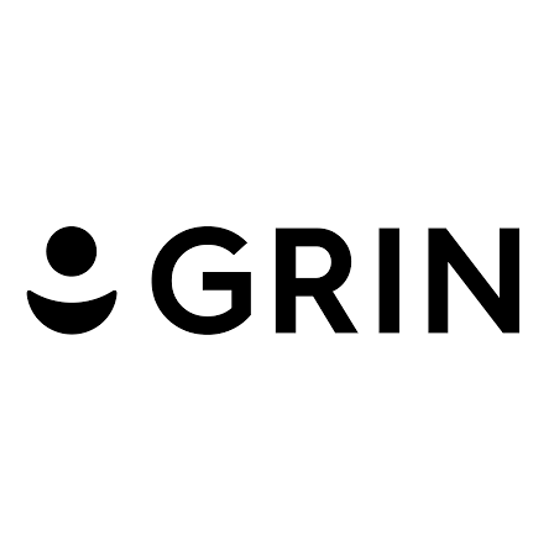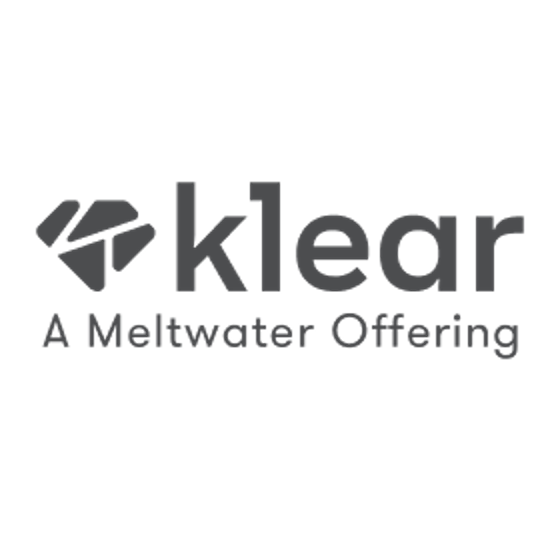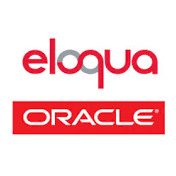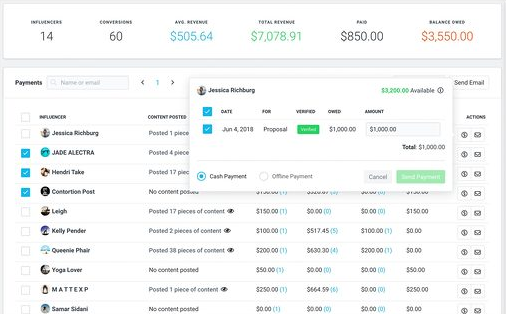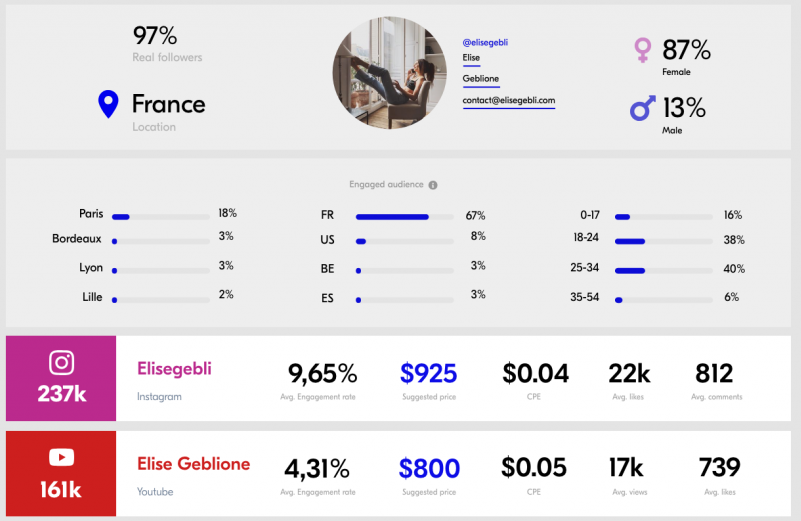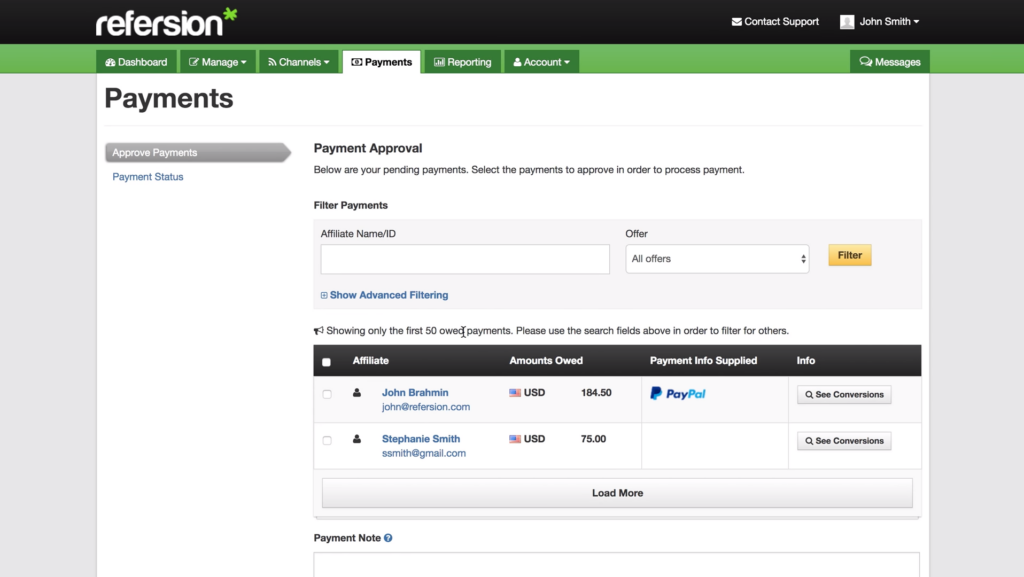10 Best Influencer Marketing Software Shortlist
Here's my pick of the 10 best software from the 19 tools reviewed.
Our one-on-one guidance will help you find the perfect fit.
The influencer marketing software space is a minefield of bloated promises and lookalike features. As a marketing leader, you’re not just looking for a database of creators—you need a strategic tool to help your team find the right partners, manage relationships, and drive measurable impact. I’ve tested dozens of platforms firsthand, and in this post, I’m cutting through the noise to share the best influencer marketing software that actually gets results.
Why Trust Our Reviews
We’ve been testing and reviewing marketing software since 2022. As marketing experts ourselves, we know how critical and difficult it is to make the right decision when selecting software.
We invest in deep research to help our audience make better software purchasing decisions. We’ve tested more than 2,000 tools for different marketing use cases and written over 1,000 comprehensive software reviews. Learn how we stay transparent & our software review methodology.
The Best Influencer Marketing Software Solutions Summary
| Tool | Best For | Trial Info | Price | ||
|---|---|---|---|---|---|
| 1 | Best for finding relevant and authentic influencers | 30-day free trial + free demo available | From $199/user/month (billed annually) | Website | |
| 2 | Best for targeted influencer discovery | Free demo available | Pricing upon request | Website | |
| 3 | Best for sourcing & ranking influencers | 14-day free trial | From $149/user/month (billed annually) | Website | |
| 4 | Best web extension tool | Not available | $999/month | Website | |
| 5 | Best for automating negotiating & contracting | Not available | From $499/month | Website | |
| 6 | Best for large enterprises | Not available | Website | ||
| 7 | Best for leveraging user generated content | Not available | Pricing upon request | Website | |
| 8 | Best choice for SMBs | 14-day free trial for new subscribers | From $99/month (paid annually) | Website | |
| 9 | Best for diversity & inclusion | Not available | Pricing upon request | Website | |
| 10 | Best for data-driven companies | Not available | Pricing upon request | Website |
-

Eloqua
Visit WebsiteThis is an aggregated rating for this tool including ratings from Crozdesk users and ratings from other sites.4.3 -

Optimizely
Visit WebsiteThis is an aggregated rating for this tool including ratings from Crozdesk users and ratings from other sites.4.2 -

Uberflip
Visit WebsiteThis is an aggregated rating for this tool including ratings from Crozdesk users and ratings from other sites.4.3
Best Influencer Marketing Software Reviews
Here’s a brief description of each influencer marketing platform to showcase each tool’s best use case, some noteworthy features, and screenshots to give a snapshot of the user interface.
Sprout Social is a social media management platform designed to help businesses with their social media presence across multiple platforms. It offers a comprehensive suite of tools for social media publishing, engagement, analytics, and reporting. Ideal for businesses of all sizes, Sprout Social caters to brands, agencies, and enterprises looking to enhance their social media strategies.
Why I Picked Sprout Social: I like that the platform allows users to discover and connect with authentic influencers through smart filters, ensuring that collaborations are relevant and effective. The comprehensive campaign management tools enable brands to handle everything from negotiations and contracts to content approval and payments, all in one place. Additionally, Sprout Social provides real-time analytics to track campaign performance, measure ROI, and optimize strategies, making it an invaluable tool for influencer marketing.
Sprout Social Standout Features & Integrations
Key features include social listening capabilities, which help brands monitor relevant conversations and identify potential influencers who are already engaging with their brand or industry. Another noteworthy feature is the detailed reporting and analytics, which provide insights into both paid and organic content performance. Sprout Social's content calendar also helps teams collaborate seamlessly, ensuring timely and coordinated social media campaigns.
Integrations include Facebook, X (Twitter), Instagram, LinkedIn, Pinterest, YouTube, Google Analytics, HubSpot, Salesforce, Zendesk, and Slack.
Pros and cons
Pros:
- Content publishing and scheduling features
- Social listening tools
- Consolidates messages from various social media platforms
Cons:
- Standard plan limits the amount of social accounts you can have
- Potentially pricey for smaller businesses
Impact.com is a partnership management platform that helps businesses discover, manage, and grow various types of partnerships, including those with influencers. It offers tools to enhance the entire partnership lifecycle, from recruitment to performance tracking.
Why I Picked Impact.com: One of the standout features of Impact.com is its comprehensive influencer discovery tool. This feature allows you to search for influencers based on specific criteria such as geographical location, social platform, follower size, and vertical. This targeted approach ensures that you can find influencers who align closely with your brand values and campaign goals, leading to more authentic and effective partnerships.
Impact.com Standout Features & Integrations
Key features include detailed insights into various metrics, including demographics, attribution, and content performance. It also offers a centralized content library where you can manage all creator-generated content in one place, making it easy to store, review, and repurpose content as needed. It even has paid amplification options, allowing you to boost the reach of high-performing influencer content directly through the system.
Integrations include Google Analytics, Shopify, BigCommerce, Stripe, PayPal, WordPress, Magento, WooCommerce, Salesforce, HubSpot, Marketo, and Mailchimp.
Pros and cons
Pros:
- Customizable commissioning tiers
- Efficient influencer recruitment
- Detailed reporting features
Cons:
- Complexity in setup for beginners
- Occasional payment issues
Brand24 serves as a streamlined influencer marketing platform, designed to efficiently identify and engage with key influencers in various industries. It offers real-time monitoring of online conversations, enabling brands to quickly spot influential voices in their niche.
Why I picked Brand24: Brand24 excels as an influencer marketing software by providing businesses with the tools to effectively identify and analyze influencers who are already engaging with their brand or could potentially amplify their marketing messages. By monitoring mentions across social media and the web, Brand24 helps companies pinpoint influencers based on the relevance of their content, engagement levels, and the reach of their audience. This enables marketers to strategically partner with influencers who align with their brand values and target audience, thereby maximizing the impact of their campaigns.
Brand24 Standout Features and Integrations
Features include a unique Influencer Score, which ranks social media influencers based on their impact in discussions relevant to your brand. This feature goes beyond traditional metrics like follower count, delving into how influential an individual is within specific conversations or topics. This targeted approach helps brands identify and collaborate with influencers who have a genuine and significant impact in areas most relevant to their products or services, rather than relying on broad, generalized influence metrics.
Integrations include Slack and SEMrush.
Pros and cons
Pros:
- Strong competitor analysis tools
- Affordable pricing makes for businesses of all sizes
- Real-time alerts let you respond to mentions quickly
Cons:
- Only supports a limited number of languages
- Could use more integrations
New Product Updates from Brand24
Brand24's One-Click Copy Feature
Brand24's Brand Assistant now allows users to copy generated texts with a single click, simplifying the process of transferring drafts, emails, or post ideas. For more details, visit Brand24 Updates.
Grin is an all-in-one creator management platform. It has features that help you run your entire influencer marketing program, from finding talent to reporting and analysis. Grin has a simple web extension tool that lets you collect potential partner profiles as you scroll through social sites in real-time.
Why I Picked Grin: Grin has a huge list of over 32,000,000 creators you can search through to find potential influencers. Each profile contains information such as the social networks the creator is active on and how many followers they have. You can also bring over your existing list of partners if you have one. Once you have found your content creators, the app simplifies the communication process. You can reach out to your partners from within the app and provide everything they need to create great content.
Grin Standout Features & Integrations
Key features include robust reporting and analysis that you can use to track campaigns in real-time. Use this to see metrics like revenue, conversions, ROI, and engagement rate. Another cool feature is the live URL. This is a proposal page you can create and send to influencers. It helps simplify campaign management by including all the information influencers need, as well as some self-service style features. For example, they can use this page to request products or view their contract terms and conditions.
Integrations include a ton of relevant tools, including social channels and ecommerce providers like Shopify and WooCommerce.
Pros and cons
Pros:
- Live proposal page with shareable URL
- Access to 32,000,000+ creators
- Browser extension for collecting social handles
Cons:
- Learning curve
- Pricing prohibitive for small biz
#Paid is a platform with specific features for matching with top creators and then turning influencer content into assets to use for paid ads. It stands out due to the unique way it connects creators and brands. Rather than using an influencer search engine, the tool automatically recommends creators who are a top match for your brand.
Why I Picked #Paid: The creators chosen through #Paid are all pre-qualified and have audiences that match your target market. They will even pitch ideas so your marketing team will get an idea of the type of content they will create for your campaign. When you find someone to work with, there are plenty of tools to streamline communication and help with content management. You can share feedback with creators within the app to ensure it meets your needs exactly.
#Paid Standout Features & Integrations
Key features include its ad whitelisting features. If you like a particular piece of content, you can use it to build ad sets for Facebook or Instagram. You can then see key campaign metrics such as the number of people you reach and the Return on Ad Spend. They also have tons of workflow automations, meaning all negotiating, contracting, payments, rights, and legal considerations can be taken care of without human intervention.
Integrations include Instagram, LinkedIn, Facebook, Twitter, and TikTok.
Pros and cons
Pros:
- Ability to automate negotiating & contracting
- Ad whitelisting turns content directly into ads
- Automatically recommends relevant creators
Cons:
- Not approrpaite for small businesses
- Few integrations available
Klear is an influencer marketing platform with all the features you need to manage campaigns. They are geared towards larger enterprises with big marketing budgets and offer access to over 30 million influencers and creators across a variety of social platforms.
Why I Picked Klear: The influencer discovery tool lets you search through profiles to find the most relevant creators for your campaign. You can narrow down the list based on filters such as location, category, and level of influence. Once you have a shortlist, it’s easy to see each person’s statistics, such as follower count, the platforms they are active on, and the engagement each post receives. Klear also has plenty of features for managing influencer relationships, such as a CRM and communication platform. This makes it easy to share the information influencers need to run successful campaigns, such as briefs, content approval, and payments.
Klear Standout Features & Integrations
Key features include a brand safety tool that highlights potential issues such as fake followers or frequent explicit language use. I also like that you can see an influencer’s previous brand affinities from within the search platform. This provides crucial insight into your competitor’s marketing strategies.
Integrations include Shopify, TikTok, Instagram, YouTube, and Slack.
Pros and cons
Pros:
- Access to 30 million+ influencers
- All-in-one influencer marketing platform
- Offers some free tools
Cons:
- Learning curve for advanced features
- Not approriate for small biz
Upfluence is influencer marketing software with all the features you need to manage campaigns, from finding talent to analyzing results. It has powerful search features with in-depth details about each person’s reach, audience, and the platforms they operate on.
Why I Picked Upfluence: Upfluence allows you to search and identify relevant influencers based on specific criteria such as industry, audience demographics, location, and social media reach. Brands can communicate their goals, provide guidelines, and share campaign details. Influencers can then create and share content in line with the brand's requirements. Upfluence offers tools for curating and organizing user-generated content. Brands can browse through the content created by influencers and select the most impactful pieces to feature on their own platforms, such as websites, social media channels, or marketing campaigns. This helps you tap into content that already exists and use it for your benefit.
Upfluence Standout Features & Integrations
Key features include built-in payment systems, which are useful if you work with a large number of influencers across different regions. The tool handles payments to people in over 200 countries. It also has an algorithm that analyzes each creator to advise you on how much to pay for a campaign. Social listening is another feature I like. It tracks all mentions of your brand and your competitors across different channels.
Integrations include plenty of CMS, affiliate, analytics, and communication tools, like Shopify, WooCommerce, BigCommerce, Klaviyo, Magento, Hootsuite, Outlook, Gmail, PayPal, Refersion, and hundreds of others if you connect them through Zapier (may incur additional costs).
Pros and cons
Pros:
- Social listening for reputation management
- Pay creators in over 200 countries
- Leverage user-generated content
Cons:
- May have to add influencers manually
- Integrations may cost extra through Zapier
Refersion is a platform that helps you connect with influencers to run affiliate marketing campaigns. It has a marketplace that makes it easy to connect with affiliates, or you can bring your own contacts into the platform. It has fair and transparent pricing that is affordable even for smaller brands or startups.
Why I Picked Refersion: Creating an affiliate campaign is easy. You just have to connect your ecommerce store provider and then create commission offers. It’s possible to create tiers so you can offer different percentages to specific groups of referrers. You can also create coupon codes that turn customers into affiliates by paying out if a friend they refer buys. Refersion makes it easy to pay your affiliates. You can create custom commission schedules and then automate payment via common methods like PayPal or bank transfer. The platform will also take care of any taxes and manage forms like W-9 or 1099s.
Refersion Standout Features & Integrations
Key features a range of advanced attribution models that allow businesses to accurately attribute conversions to the appropriate affiliates. While many affiliate marketing platforms use a last-click attribution model by default, Refersion goes beyond this and provides options like first-click, multi-touch, and custom attribution models. They also have a unique focus on affiliate programs, letting you quickly and easily create affiliate links to products/services you want to highlight and offer commission rates for those who sign on.
Integrations include Shopify, BigCommerce, WooCommerce, PayPal, Trolley, and Amazon, as well as access to developer APIs for more DIY options.
Pros and cons
Pros:
- Build and manage affiliate programs
- Advanced attribution models for reporting
- Price inclusivity for SMBs
Cons:
- Unlimited order conversions for highest plan only
- UX could use updating
Captiv8 is a tool with plenty of features to help you discover creators, run campaigns, and measure results. It has a huge influencer marketplace with over 30 million people. While this could be overwhelming, it also has AI-powered discovery features and over 500 filters you can use to narrow this list down to the top influencers.
Why I Picked Captiv8: Captiv8 is a standout platform for influencer marketing, particularly due to its commitment to diversity and inclusion. Captiv8 recognizes the importance of representing diverse perspectives and ensuring fair and inclusive influencer campaigns. The platform offers a comprehensive database of diverse influencers across various demographics, including race, gender, ethnicity, and sexual orientation. Captiv8's emphasis on diversity and inclusion enables brands to reach and engage with audiences from different backgrounds, fostering authenticity and cultural relevance in their influencer marketing initiatives.
Captiv8 Standout Features & Integrations
Key features include advanced data analytics. For example, you can analyze your competitors’ social activity to see what works for these brands. And you can launch paid advertising campaigns from within Captiv8 to boost campaign impact. Additionally, Captiv8's content search engine is a powerful tool that enables brands to discover user-generated content across various social media platforms. This feature allows brands to identify trending topics, monitor brand mentions, and curate user-generated content for amplification.
Integrations include TikTok, Facebook, instagram, YouTube, Twitter, Pinterest, Shopify, Tableau, and Google Analytics.
Pros and cons
Pros:
- Intuitive, easy-to-use platform
- Competitor analytics tools
- Focus on diveristy & inclusion in campaigns
Cons:
- Can't add custom KPIs to the talent list dashboard
- Complex, multi-step payment processing
NeoReach is an influencer marketing tool that stands out due to its full-service offering. It’s part software, and part influencer marketing agency. If you choose the managed services plan, the NeoReach team will run your entire influencer marketing strategy for you, from sourcing influencers to reporting. It’s a unique solution if you want to completely hand off campaign management to someone else.
Why I Picked NeoReach: NeoReach is a powerful influencer marketing platform that stands out due to its extensive range of native integrations. With a diverse array of integrations available, NeoReach seamlessly connects with various social media platforms, analytics tools, and content management systems. They primarily leverage integrations to make sure you have all the information you need to make data-driven campaign decisions. Their API allows you to mix and match the important datasets from their database to create the exact parameters that you're looking for, be it the fastest growing channel in a niche hobby community or spotting high profile accounts according to native language preferences.
NeoReach Standout Features & Integrations
Key features include AI-powered technology analyzes vast amounts of data to identify influencers who are the best fit for a brand's campaign objectives, target audience, and brand values. By using machine learning algorithms, NeoReach can efficiently identify influencers who have the highest potential to drive engagement. NeoReach also offers advanced features such as automated outreach, content approvals, and centralized communication channels.
Integrations include YouTube, Twitter, Instagram, Facebook, Twitch, TikTok. as well as 400+ network endpoints that can pull and parse advanced data sets into whatever insights you are looking for.
Pros and cons
Pros:
- Easy to learn and use, good UI
- Great for agencies who work with many brands
- Focus on social data collection and sorting
Cons:
- May have to upload micro influencers yourself
- Generally geared towards bigger brands
Other Influencer Marketing Software
Here’s a few more tools that didn’t make the top list.
- IZEA
For outsourcing influencer management
- CreatorIQ
For competitor benchmarking
- Brandbassador
For gamified engagement
- PartnerStack
For partner ecosystems with influencers
- AspireIQ
Connect with a network of over 6 million influencers
- influence.co
Create briefs and let influencers come to you
- Influsoft
Generate in-depth insight into influencer marketing campaigns
- Mavrck
Influencer marketing for enterprise customers
- impact.com
For advanced influencer discovery and recruitment
Related Marketing Tool Reviews
If you still haven't found what you're looking for here, check out these tools closely related to digital marketing strategy that we've tested and evaluated.
- Marketing Software
- Marketing Management Software
- Account Based Marketing Software
- Social Media Management Software
- Email Marketing Software
Selection Criteria for Influencer Marketing Software
Selecting the right influencer marketing software involves a careful evaluation of what they have to offer. Through extensive personal trials and research, I've developed criteria to guide software buyers towards making an informed decision.
Core Influencer Marketing Software Functionality: 25% of total weighting score
- Identification and vetting of influencers who align with brand values and target audiences.
- Management of campaign workflows from inception to completion.
- Tracking of campaign performance and analytics in real-time.
- Measurement of ROI and impact analysis.
- Integration capabilities with other marketing tools and platforms.
Additional Standout Features: 25% of total weighting score
- Look for tools that offer predictive analytics for influencer performance and campaign outcomes, not commonly provided by all competitors.
- Unique content collaboration features, allowing for seamless co-creation between brands and influencers.
- Advanced AI-driven insights into influencer audience demographics and psychographics.
- Tools like CreatorIQ and AspireIQ stand out by providing these innovative functionalities, setting them apart from standard offerings.
Usability: 10% of total weighting score
- Prioritize interfaces that offer intuitive navigation and a streamlined user experience, balancing complexity with ease of use.
- Effective influencer marketing tools should include drag-and-drop features for campaign management and scheduling.
- A clean, uncluttered design aesthetic that enhances rather than hinders functionality is essential.
Onboarding: 10% of total weighting score
- Evaluate tools based on the availability of comprehensive training resources such as videos, templates, and product tours.
- Look for platforms that offer quick and interactive onboarding experiences, including personalized support like chatbots and live webinars.
Customer Support: 10% of total weighting score
- The presence of a responsive, knowledgeable support team ready to assist with both technical and campaign strategy questions.
- Multiple support channels, including live chat, email, and phone support, indicating a commitment to customer satisfaction.
Value For Money: 10% of total weighting score
- Assess pricing structures in relation to the suite of features offered, ensuring the tool provides a solid return on investment.
- Consideration of flexible pricing options, including tiered plans that accommodate businesses of different sizes and needs.
Customer Reviews: 10% of total weighting score
- Analyze feedback from current and past users to gauge overall satisfaction, focusing on comments related to usability, support, and results.
- High ratings in areas like ease of use, customer service, and feature set effectiveness are strong indicators of a tool's value to its user base.
With influencer marketing software selection, the focus isn't just on finding a tool with a good user interface but on identifying one that aligns closely with your marketing strategy's needs.
How to Choose the Best Influencer Marketing Platform
With so many different influencer marketing software available, it can be challenging to make decisions on what influencer marketing software is going to be the best fit for your needs.
As you're shortlisting, trialing, and selecting influencer marketing software, consider the following:
- What problem are you trying to solve - Start by identifying the influencer marketing feature gap you're trying to fill to clarify the features and functionality the influencer marketing software needs to provide.
- Who will need to use it - To evaluate cost and requirements, consider who'll be using the software and how many licenses you'll need. You'll need to evaluate if it'll just be the marketing team, or the whole organization that will require access. When that's clear, it's worth considering if you're prioritizing ease of use for all, or speed for your marketing software power users.
- What other tools it needs to work with - Clarify what tools you're replacing, what tools are staying, and the tools you'll need to integrate with, such as accounting, CRM or HR software. You'll need to decide if the tools will need to integrate together, or alternatively, if you can replace multiple tools with one consolidated influencer marketing software.
- What outcomes are important - Consider the result that the software needs to deliver to be considered a success. Consider what capability you want to gain, or what you want to improve, and how you will be measuring success. For example, an outcome could be the ability to get greater visibility into performance. You could compare influencer marketing software features until you’re blue in the face but if you aren’t thinking about the outcomes you want to drive, you could be wasting a lot of valuable time.
- How it would work within your organization - Consider the software selection alongside your workflows and delivery methodology. Evaluate what's working well, and the areas that are causing issues that need to be addressed. Remember every business is different — don’t assume that because a tool is popular that it'll work in your organization.
Trends in Influencer Marketing Software for 2025
Here are some trends I’ve noticed for influencer marketing technology, plus what they might mean for the future of the marketing industry. I sourced countless product updates, press releases, and release logs to tease out the most important insights.
- Integration with Emerging Social Platforms: The most rapidly evolving influencer marketing software is extending its reach beyond traditional social networks to include emerging platforms like TikTok and Twitch. These end-to-end solutions are built to help the modern marketing manager engage younger, niche audiences where they’re most active, tapping into both influencer reach and organic UGC potential.
- AI-driven Influencer Matching and Predictive Analytics: Cutting-edge tools are leveraging artificial intelligence to enhance influencer discovery and using enriched influencer profiles to improve the match-making processes. Predictive analytics is being used to forecast campaign performance, enabling brands to make data-informed decisions. This trend underscores the shift towards more strategic, outcome-focused influencer marketing.
- Advanced Reporting and ROI Measurement: Features enabling granular tracking of campaign performance and ROI are in high demand. Today's influencer marketing software that offers comprehensive analytics dashboards, real-time data tracking, and customizable reporting functions are leading the charge, reflecting the growing need for accountability and measurable results in marketing investments.
- Enhanced Content Collaboration Tools: Novel functionalities facilitating smoother collaboration between brands and influencers, such as shared content calendars, approval workflows, and real-time feedback mechanisms, are emerging. These tools aim to streamline the content creation process, reflecting the critical importance of producing authentic, brand-aligned content efficiently.
- Declining Emphasis on Follower Count: Features focusing solely on an influencer's follower count are becoming less emphasized. Instead, there's a pivot towards engagement rates, audience demographics, and content relevance. This shift indicates a more nuanced approach to influencer selection, prioritizing quality and relevance over sheer reach.
These trends reveal a clear trajectory towards more sophisticated, outcome-oriented influencer marketing strategies. This evolution reflects a deeper understanding of the challenges marketing professionals face and the innovative solutions being developed to address these needs.
What is Influencer Marketing Software?
Influencer marketing software is a digital tool designed to help businesses identify, connect with, and manage relationships with social media influencers. The purpose is to streamline the process of finding influencers whose audience demographics and interests align with the brand's target market. It typically includes features for campaign management, performance tracking, and analytics to measure the effectiveness of influencer partnerships.
Features of Influencer Marketing Software
The key features of the tools on this list are influencer directories and management. But they also offer plenty of extras, too. Here are the main features to look out for.
- Influencer directory: An influencer directory is a key part of all these platforms. It allows companies to find creators and also provides important details about each one, such as their reach and the platforms they operate on.
- Filters and recommendations: Many of the databases have millions of influencers. It’s essential that your platform has ways to find the best-suited people. Filters are a common feature, and some tools even have AI recommendations.
- Influencer management: Some of the platforms have influencer management features that allow you to manage your campaigns and communicate with your brand’s influencers.
- Influencer import: If you already partner with influencers, you need a way to bring these relationships into your new platform. The best solutions make this easy to do.
- Payment: Making payments to multiple influencers is a complex process, especially if they are spread across the globe. Some of the tools on this list handle payments for you.
- Affiliate management: If you want to run affiliate campaigns, your influencer marketing software should manage commissions and referrals. Some of the tools on this list have these features.
- Paid ad integration: Some tools integrate with paid ad platforms so you can quickly spot high-performing content and use it in your ads. It’s an easy way to manage and optimize paid digital marketing campaigns.
Benefits of Influencer Marketing Software?
In the digital age, influencer marketing has become an indispensable an indispensable part of any successful social media marketing strategy. Here are five primary benefits of using influencer marketing software for users and organizations:
- Enhanced Influencer Discovery: Quickly identifies influencers who align with your brand's values and target audience. This software cuts down the time and effort needed to find suitable influencers, making it easier for businesses to partner with content creators who can authentically promote their products or services.
- Efficient Campaign Management: Simplifies the coordination of multiple influencer campaigns. With features like campaign tracking, communication tools, and payment processing, the software enables users to manage campaigns from start to finish in one platform, saving time and reducing administrative burden.
- Data-Driven Insights: Provides analytics and performance metrics for informed decision-making. By leveraging software that analyzes campaign effectiveness, brands can understand their return on investment (ROI) better, allowing for adjustments to strategies that enhance future marketing efforts.
- Scalability: Facilitates the growth of influencer marketing efforts without a proportional increase in effort or resources. This software supports the efficient scaling of campaigns, enabling businesses to reach larger or more targeted audiences as their marketing strategies evolve.
- Improved ROI Measurement: Offers tools for accurately tracking and measuring the success of influencer marketing campaigns. With detailed analytics on engagement, conversions, and other key performance indicators (KPIs), organizations can quantify the impact of their influencer partnerships, ensuring resources are directed toward the most effective strategies.
These benefits underscore the value of incorporating influencer marketing software into your digital marketing toolkit, enabling more effective, efficient, and measurable marketing outcomes.
Cost & Pricing of Influencer Marketing Software
Navigating the landscape of influencer marketing software can be a daunting task for software buyers who are new to the field. Here's a breakdown of common plan options and their pricing to help guide your decision-making process.
| Plan Type | Average Price | Common Features Included |
|---|---|---|
| Starter | $29 - $99 per month | Access to basic influencer discovery tools, campaign management features, and standard reporting capabilities. |
| Professional | $99 - $499 per month | Advanced influencer search capabilities, enhanced campaign management tools, deeper analytics, and more integrations. |
| Enterprise | $500+ per month | Customizable features, full API access, dedicated support, comprehensive analytics, and unlimited campaigns. |
| Free Option | $0 | Limited influencer search capability, basic campaign tracking, and some reporting features. |
When choosing an influencer marketing software plan, consider the size of your influencer campaigns and the depth of analytics you require. Keep in mind that the best choice will balance the features you need against your available budget, ensuring you're not paying for functionalities you won't use.
Frequently Asked Questions
Here are a few Q&As I thought might be useful in the realm of influencer marketing software.
How do I find the right influencer for my brand?
Finding the right influencer for your brand is a crucial step in leveraging influencer marketing effectively. It involves a strategic approach that goes beyond product seeding. It’s about aligning an influencer with your brand’s values, target audience, and marketing goals. Here’s how to go about it:
1. Define Your Goals: Clearly outline what you want to achieve with your influencer marketing campaign, whether it’s increasing brand awareness, driving sales, or promoting a new product launch. Your goals will influence the type of influencer you should partner with.
2. Understand Your Audience: Know who your target audience is and what they value. This understanding will help you identify influencers who already engage with similar demographics and whose followers are likely to be interested in your brand.
3. Research Influencers: Start by searching for influencers within your niche using social media platforms, influencer marketing software, or by following relevant hashtags. Look for content creators whose brand and style align with your own.
4. Evaluate Engagement Rates: An influencer’s value is not just in their follower count but in how engaged their audience is. High engagement rates often indicate a loyal and active following, which is more valuable for your campaign’s success.
5. Assess Content Quality and Relevance: Review the influencer’s content to ensure it matches your brand’s quality standards and is relevant to your products or services. The influencer’s content style, tone, and aesthetics should complement your brand.
6. Check for Authenticity: Authentic influencers share their genuine opinions and build trust with their audience. Evaluate their previous partnerships and endorsements to ensure they are selective and authentic in their promotions.
7. Consider Budget and Collaboration Terms: Determine if the influencer’s rates are within your budget and what their collaboration terms involve. It’s important to have clear communication about expectations, deliverables, and compensation.
8. Use Influencer Marketing Platforms: These platforms can simplify the search and vetting process by providing access to databases of influencers, complete with analytics and engagement metrics to help you make informed decisions.
9. Engage in Preliminary Conversations: Reach out to potential influencers with a personalized message. Discuss your campaign goals, expectations, and see if there’s a mutual interest in collaborating. This is also a good time to gauge their professionalism and enthusiasm for your brand.
10. Trial Campaigns: Consider running a smaller, trial campaign with a shortlist of influencers to see how well they resonate with your audience and meet your campaign goals before committing to a longer-term partnership.
Finding the right influencer requires a combination of strategic research, careful consideration of engagement and authenticity, and clear communication of your marketing goals. By taking these steps, you can establish fruitful partnerships that benefit both your brand and the influencers you choose to work with.
What KPIs should I use for influencers I work with?
Tracking the success of influencer marketing campaigns involves monitoring specific Key Performance Indicators (KPIs) that align with your campaign goals. Selecting the right KPIs is crucial for measuring the effectiveness of your influencer collaborations and making informed decisions for future campaigns. Here are essential KPIs to consider:
1. Engagement Rate: This is one of the most critical KPIs for influencer marketing. It measures how actively involved the audience is with the influencer’s content through likes, comments, shares, and saves. A high engagement rate indicates that the content is resonating well with the audience.
2. Reach and Impressions: Reach refers to the number of unique viewers who see the influencer’s content, while impressions track how many times the content is displayed, regardless of clicks or interactions. These metrics help gauge the breadth of visibility your campaign is getting.
3. Click-through Rate (CTR): For campaigns aimed at driving traffic to a website or landing page, CTR is vital. It measures the percentage of viewers who click on the link provided in the influencer’s content, indicating the effectiveness of the call-to-action.
4. Conversion Rate: This measures the percentage of users who take the desired action after clicking on the link in the influencer’s content, such as making a purchase, signing up for a newsletter, or downloading a guide. Conversion rate is crucial for campaigns with direct sales or lead generation objectives.
5. Follower Growth: Tracking the increase in your brand’s social media followers during and after an influencer campaign can indicate the campaign’s effectiveness in boosting brand awareness and attracting new audience members.
6. Brand Sentiment: Analyze comments, shares, and mentions to gauge the audience’s sentiment towards your brand in the influencer’s content. Positive sentiment can enhance brand reputation, while negative sentiment may require addressing any concerns or misconceptions.
7. Content Quality and Relevance: Though more qualitative than quantitative, assessing the quality and relevance of the influencer’s content in relation to your brand is essential. High-quality, relevant content is more likely to engage the target audience and achieve campaign goals.
8. Cost Per Engagement (CPE): This measures the cost-effectiveness of your influencer marketing efforts, calculating how much you spend for each interaction (like, comment, share) received on the influencer’s content related to your campaign.
9. Return on Investment (ROI): Ultimately, calculating the ROI of your influencer marketing campaigns is crucial. This involves comparing the revenue or value generated from the campaign against the costs involved, providing a clear picture of its financial effectiveness.
By closely monitoring these KPIs, you can evaluate the performance of your influencer marketing campaigns, identify areas for improvement, and make data-driven decisions to enhance future collaborations and marketing strategies.
What influencer marketing software is best for small teams?
Smaller brands or companies may think that influencer marketing software and influencer costs are out of their reach. But that’s not entirely true. There are many influencers with small but dedicated audiences who expect to work with smaller brands and whose pricing fairly reflects that. For the smallest of small teams, you might be better off just doing your own research online and reaching out to “micro influencers” yourself with a proposal and budget. However, if you have the budget you might consider Hubble.me ($99/month) or Shoutcart (10% or $10/influencer, whichever is greater).
Additional Advocacy Software Reviews
Below, you’ll find other advocacy software reviews that discuss and evaluates other tools that empower others to promote your organization.
- Customer Advocacy Software
- Affiliate Marketing Software
- Social Listening Tools
- Employee Advocacy Software
- Brand advocacy software
The Takeaway
Influencer marketing can be a great way to build brand awareness. A recent survey found that 80% of marketers find it to be effective, while 58% say it is the most effective form of marketing. This list will help you find what infuencer marketing software will work best for your campaign ideas and brand needs. Use these tools to find your people and, through them, find new audiences.
Don't forget to subscribe to The CMO newsletter for more marketing tips, roundups, and reviews.




